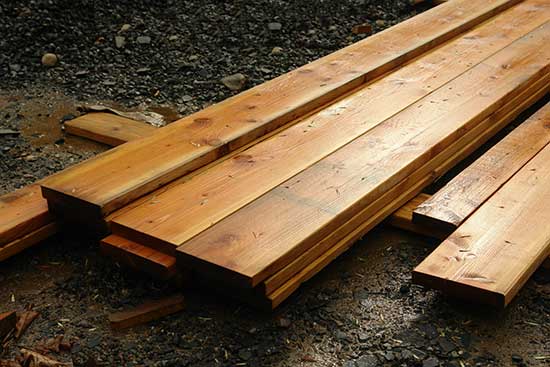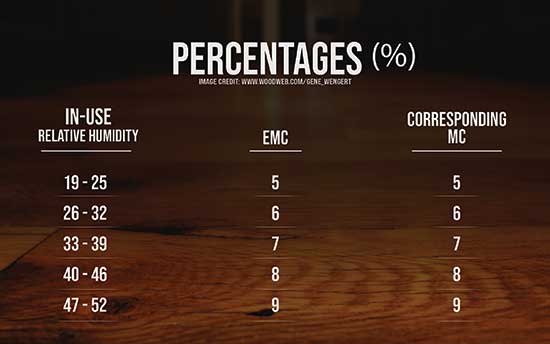How Wood Responds to Changes in Temperature and Humidity
 Everyone working with wood understands that wood reacts to its environment. In particular, the effect of temperature and humidity on wood and its moisture content (MC). And it’s the fluctuations in MC that cause the wood to react. The same wood species will respond differently to different environments.
Everyone working with wood understands that wood reacts to its environment. In particular, the effect of temperature and humidity on wood and its moisture content (MC). And it’s the fluctuations in MC that cause the wood to react. The same wood species will respond differently to different environments.
The United States has five main climate zones. Each imposes a unique impact on wood. The southeast gets quite hot and humid. Yet it experiences a narrower temperature range than the northeast. The northeast generally gets only semi-humid at best, and that’s only in the summer. Winters in the northeastern United States are dry and bitterly cold.
It’s vital to understand how different ambient conditions impact wood. This is true whether you lay wood flooring, craft wood furniture, or work with wood in some other way.
This isn’t to say there are regions where wood shouldn’t or can’t be used, but regardless, you need to be mindful of the situation and region you are in. Wood construction is booming in Saudi Arabia but as interior elements. Conversely, wood is also used to sandwich insulation layers in construction on the Arctic Circle. It’s simply an issue of knowing and planning for how your wood will react to the climate
Even the seasonal and daily variation in ambient conditions affect wood. There’s no avoiding it. Temperature and humidity impact your woodwork, wherever it is.
The short story on why temperature and humidity affect wood
 The “Wood Doctor,” Gene Wengert, explains that wood shrinks and swells in response to changes in its MC. That begs the question: Then, what causes changes to a wood specimen’s MC?
The “Wood Doctor,” Gene Wengert, explains that wood shrinks and swells in response to changes in its MC. That begs the question: Then, what causes changes to a wood specimen’s MC?
Wood holds moisture in its cavities and in its cells. The cells change shape when they absorb or release moisture, changing the physical condition of the wood. The air also holds moisture; that’s the humidity. The relative humidity (RH) is the percentage of moisture in the air relative to what the air can hold. Air with colder temperatures can hold less moisture than warmer temperatures.
That’s why two environments with the same absolute humidity will have different RH if their air temperatures differ. The RH during the warmer summer months in Provo, Utah runs 40 points lower than its average RH during its colder months. In contrast, hot and humid Houston’s RH sits consistently in the mid-70s all year.
Wengert also explains why RH is so important to understand how the wood will react in a specific environment. If the MC of the wood and the air haven’t reached an equilibrium, they’ll exchange moisture.
Wood with a low MC in an environment with a high RH will suck moisture out of the air and absorb it. If the air has a low RH and there’s excess moisture in the wood, it will evaporate. In both instances, the movement of moisture into or out of the wood can cause it to shrink, expand, warp, or crack.
The goal, according to the Wood Doctor, is to let wood reach its point of equilibrium moisture content (EMC) before engaging it in any sort of building process. EMC is the point at which the moisture conditions of both the wood and air have equalized, and they’ll no longer exchange moisture.
 Wengert charts estimated EMC relative to RH and temperature. Thus, when you know what the service condition RH and temperature are on a project, you have an approximate EMC percentage too. Use that approximate EMC percentage to guide decisions about the target MC for the wood that will be living there.
Wengert charts estimated EMC relative to RH and temperature. Thus, when you know what the service condition RH and temperature are on a project, you have an approximate EMC percentage too. Use that approximate EMC percentage to guide decisions about the target MC for the wood that will be living there.
Generally, an RH between 30 to 50 percent in North America corresponds to six to nine percent EMC. Yet this is too broad a rule to help you determine a wood specimen’s target MC under specific conditions. You need to consider many variables:
Is the wood intended for interior or exterior use? HVAC systems mean interiors with a stable room temperature will typically have less variation in their ambient conditions.
How wildly do ambient temperature and RH fluctuate throughout the year? Even interior wood is impacted by this as HVAC settings will change across the seasons.
What’s the wood species? Some species, like American Beech, Teak, and Hickory, tolerate moisture and humidity well. The Magnolia and American Elm can withstand the cold.
Another important issue is where you leave the wood to acclimate. It should always acclimate under service conditions or the EMC point will shift once it’s installed. A change in the EMC target point means the wood and air will go through a period of exchanging moisture. Exactly what you want to avoid. The wood’s MC should be within an acceptable range of the estimated EMC point before permanent installation.
 Of course, this requires you to have an accurate measure of the wood’s MC.
Of course, this requires you to have an accurate measure of the wood’s MC.
Using the right tool to measure wood’s MC and EMC
Using a wood moisture meter that measures MC accurately is the best way to start. Yet knowing a wood specimen’s MC is only one piece of the equation. You need to know if the wood’s MC has equilibrated with its environment.
The formula to calculate EMC uses the air’s RH and temperature and is quite complicated. Wagner Meters, a long-time provider of wood moisture meters, recently released the Orion® 950 Smart Pinless Wood Moisture Meter, a wood moisture meter that also calculates EMC for you. Having a computer to calculate EMC for you makes the decision whether to continue with the project easier and probably a lot faster unless you have a calculator or chalkboard handy.
The Orion 950 also comes with an industry-exclusive “On-Demand Calibrator” that actually allows you to calibrate the meter wherever you are in less than 20 seconds. Many wood meters feature a “calibration reference” that can maybe tell you approximately how far off calibration the meter is, but If the meter is out of calibration, you would have to send the meter to the factory for calibration. Wagner Meters also offers a NIST-traceable version of the “On-Demand Calibrator” tool for companies that need to align with ISO standards of excellence.
You can learn more about the Orion 950. If you want to explore RH and EMC in greater depth, check out Gene Wengert’s website.
As Sales Manager for Wagner Meters, Ron has more than 35 years of experience with instrumentation and measurement systems in different industries. In previous positions, he has served as Regional Sales Manager, Product and Projects Manager, and Sales Manager for manufacturers involved in measurement instrumentation.
Last updated on December 9th, 2025



